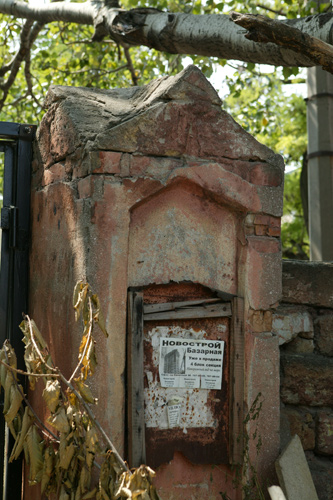New York City Fusion II
I’m starting to collect photos of NYC restaurants that offer unlikely combinations of cuisines.
Where else can you get humus, naan and tabouli at the same time?
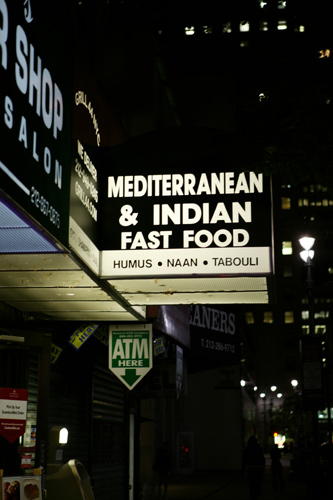
What’s the weirdest combination that you’ve seen?
The Way Cool License Plate Book
Everywhere you go you see vanity plates. The best of them are those that make you think and then reward you with a good laugh. Now there is a book that captures all the fun and excitement of vanity plates from across North America.
Inside The Way Cool License Plate Book you’ll find plates that show how their owners feel about the cars they drive (or wish they drove!), the work they do, the sports they play and the dreams they have.
This book is the perfect companion for any vacation or road trip. Parents will be happy knowing that the games in this book strengthen math and reading skills as well as provide hours of fun. Kids will enjoy spotting plates from across the country and reading the hundreds of vanity plates inside. Categories of vanity plates include:
-
Cars
The work we do
Sports
Animals
Places
Music
PL8 fun
and there are 8 pages of games for car trips.
The Official License Plate Book 2002: A Complete Plate Identification Resource (License Plate Book)
Nice Plates
Crown Vic with plates like that can probably park just about anywhere in New York with no fear of getting a ticket. Except maybe in front of the City Hall.
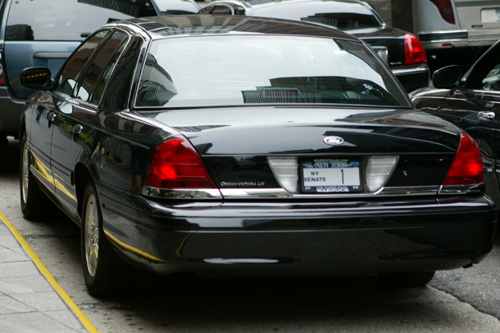
Office Design (Design Books)
At the beginning of the 19th century, Charles Fourrier observed that citizens’ lives were marked not by the home but by the office; 200 years later, this somewhat eccentric statement expresses the reality of post-industrial society: In Western countries, one of the consequences of the globalization of the economy has been the concentration of workers in the tertiary sector; more than half of the population works in offices. Offices have become domestic, the relationship between workmates has become closer and their workplace seems increasingly like a club or house in which they spend the greater part of the day. All presented projects feature inspiring ideas of designing more efficient, modern and more pleasant working environments.
Tolomeo Mini Table Task Lamp by Artemide
The Tolomeo Mini Table Task Lamp is a standing luminaire for orientable direct task lighting. Fully adjustable articulated arm body structures in extruded aluminum. Joints, tension control knobs and base in Polished Die-cast Aluminum. Tension cables in Stainless Steel. Diffuser in stamped, Anodized Matte Aluminum, rotatable 360 degrees on lampholder with incorporated on/off switch. Available in Polished Aluminum, White or Black finish. Shown in Aluminum finish. One 100 Watt 120 Volt E26/G16Cl incandescent lamp (not included). Also available with Fluorescent lamping and in a smaller and larger size. Designed by Michele De Lucchi and Gerhard Fassina in 1987-1991. UL Listed. Made in Italy. Shipping: Shipping information will be emailed to you within two business days after placing an order. Dimensions: Base: Diameter 7.75 in. Fixture: Overall Length 40.5 in. Height 21 in. Reach 26.75 in.
Leading By Design: The Ikea Story
Based on exclusive interviews with the legendary founder of IKEA, Ingvar Kamprad, Leading by Design tells the inside story of Kamprad’s humble roots and of the visionary concepts and innovative strategies that turned a small, Swedish mail-order company into a worldwide commercial giant.
When in 1943 at age seventeen Ingvar Kamprad founded IKEA, he had no way of knowing that IKEA would come to represent dedication to quality, a distinct design style, and convenience to the harried modern consumer. Today, more than 195 million people worldwide frequent his 150 stores in thirty countries, and almost 100 million catalogs are printed each year.
As the grandson of German immigrants who went to Sweden in search of a better life, Ingvar Kamprad grew up on a farm in a rural village. But he was no farmer. Early in his life, he discovered his natural affinity for business. From cigarette lighters and fish to Christmas cards and pens, young Ingvar devoted himself to importing and selling anything he thought he could make a profit on. Furniture was just one item in a long and fairly undistinguished list’until, in an effort to best his main competitor, he took a chance on an armless nursing chair he called Ruth. It quickly sold out. Adding a coffee table and then a sofa bed and then a chandelier, Kamprad was astonished by how quickly the merchandise moved.
The rest is business history. In Leading by Design, Bertil Torekull, a well-known Swedish journalist, reveals the genius and the secrets behind IKEA’s extraordinary success. With candor and detail, he offers insights into Kamprad’s cutting-edge management strategies, his enthusiasm to embrace innovative methods (such as producing ready-to-assemble merchandise and using a car door factory to produce affordable products with universal appeal), and the tools he used to grow the IKEA brand into a veritable industry unto itself.
More than a standard business history Leading by Design captures the essence of Kamprad himself. It is a testament to the inspiration, the ideas, and the innovations that make a good business great.
The House of Lamps or Lamp Lust
I firmly believe that expensive and well designed office chairs like Aeron or Mirra make a very good investment. On the other hand my friend, a very successful entrepreneur, tells me that much cheaper 300 dollar chairs are just as good, and that his most prized employees, when asked what kind of a chair they want said that it does not matter. My friend is very smart, very rich, and probably right.
People who have chair lust, like me, sometimes have an even more irrational desire – to buy expensive table lamps. When Joel Spolsky visited me at work, i pointed out to him that everyone at my office had a four hundred dollar Artemide Tolomeo desk lamp. Joel, famous for his office architecture fetish, was not impressed — oh yeah, we have a whole bunch of them too at Fog Creek, — he said.
I noticed that the set designer of the hit show House, MD also has an obsession with lamps. Even more interestingly, I noticed that Dr House’s office has three very interesting lamps.
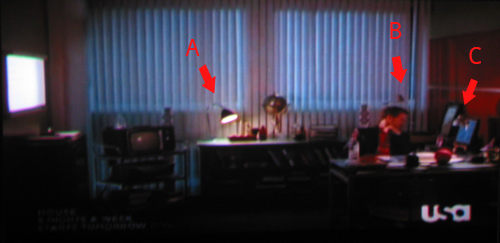
Lamp A is a paragon of British design, Bestlite, a lamp that I always wanted, and never bought because it’s crazy to spend that much money on a lamp. Designed by Robert Dudley Best and made famous by Winston Churchill, who had one in his office, it’s the Bentley of expensive designer lamps. It’s just crazy to spend over $600 on a lamp, innit?
Lamp B is the Artemide Tolomeo, a floor version of the lamp that I have at work. It’s a beautiful lamp that works very well. The desk version is about half the price of Bestlite, but it’s crazy to spend $300 on a lamp, right? Even if it’s designed by Michele De Lucchi and Giancarlo Fassina?
Lamp C appears all throughout Princeton-Plainsboro Teaching Hospital and gets the most screen time. It’s a 25 dollar Antifoni work lamp from Ikea, and the one that I have on my desk at home. Who designed it? I don’t know, it says “Ikea of Sweden”. What does Antifoni mean? According to Nordic Names, a website for translating crazy Ikea names like Bjöberg and Drömma, it means “antiphony“.
By the way, apparently Ikea founder Ingvar Kamprad has a Nazi past and chose to name all the furniture because SKUs were hard for him to keep track of due to his dyslexia. Also Gillis Lundgren, besides being famous for designing the Billy bookcase (I have 12 of these in my apartment) , actually invented the concept of flat pack furniture when he sawed off legs from a table that would not fit into a car.
Also on the subject of Ikea lamps:
Deadprogrammer Visits Odessa : Part II : Balconies and Yards
When I think about Odessa, I often remember the title of Robert Heinlen’s novel, “The Door into Summer“. Odessa is a summer city. If I were to pick one word to describe it in the summer, it would be sun-dappled.
The soil in Odessa is pretty bad, and there aren’t any local sources of fresh water. Because of that there are only three types of trees that thrive there: acacia, sycamore (locally known as “shameless” trees because they shed their bark), and horse chestnut. Acacia is one of the symbols of Odessa, and horse chestnut is that of Kiev. These trees are thriving in Odessa, and many hundred year old specimens provide a lot of shade.
The tree shade and the bright sun bathe everything in these spots of light, like in Renoir’s La Moulin de la Galette.
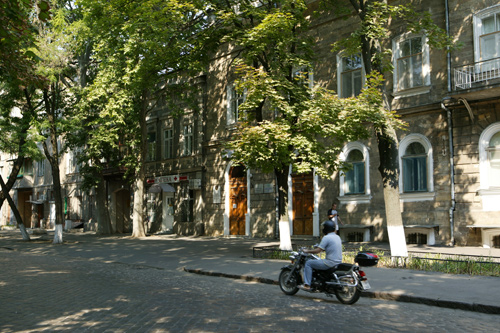
Here’s a very old acacia on the corner of the street where I grew up. Notice the parking sign: in Odessa the sidewalks are so wide that cars can be parked on them. Also, they are now selling melons out of cages that are locked for the night. Acacia blossoms cover all the sidewalks and produce and intoxicating aroma.
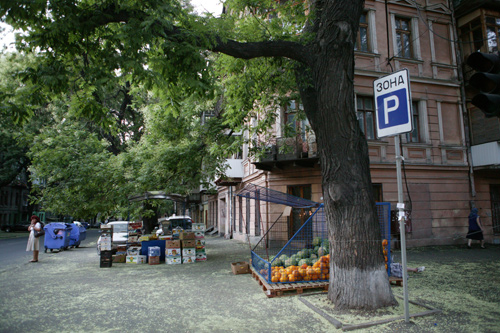
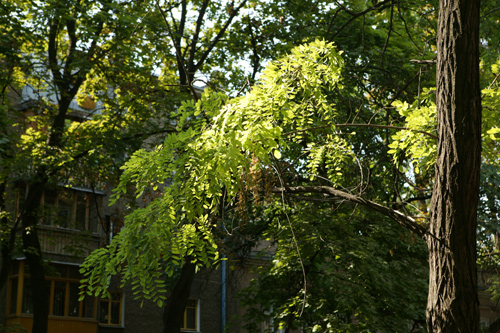
As I mentioned before, Odessa was built on the grand scale and by the best architects. Even the lesser buildings are very decorated. Atlases were very popular.
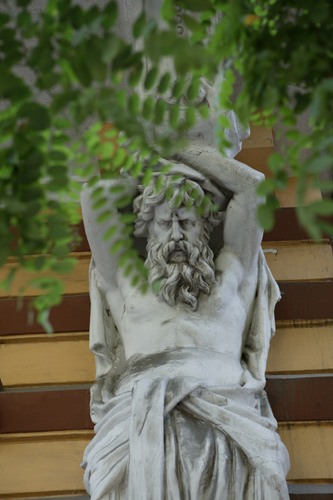
Apparently the current location of Odessa used to be under the Black sea, and the bedrock consists of a somewhat soft yellow sedimentary rock formed out of shells of sea creatures. It’s a type of limestone, I guess. This rock turned out to be a perfect building material: cheap and abundant, soft enough to cut and carve, but durable enough to build with, not too heavy, very good for thermal and sound isolation. So many buildings were built this stone that the quarries below the city formed a humongous labyrinth known as “catacombs“. It was used by contraband smugglers and WWII guerrilla fighters. It would have been super easy to build a subway in Odessa, but somehow it never happened.
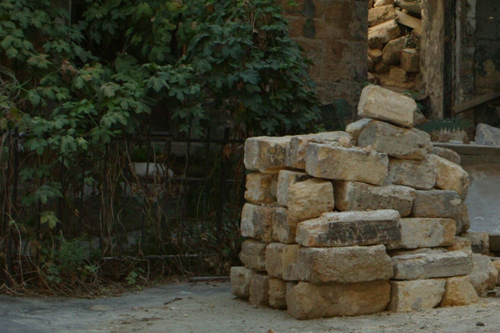
There are two architectural features of the old limestone buildings that became very important in the Odessa way of life: balconies and courtyards. Just like the wide sidewalks, these are the artifacts of the town mostly built in 1800s, in the era of horse buggies, no air conditioning, and gas light. Balconies provided a breath of fresh air, and internal courtyards let architects let in light into all apartments.
Some balconies are very charming, with cast iron railings and pleasing shapes and aging gracefully.
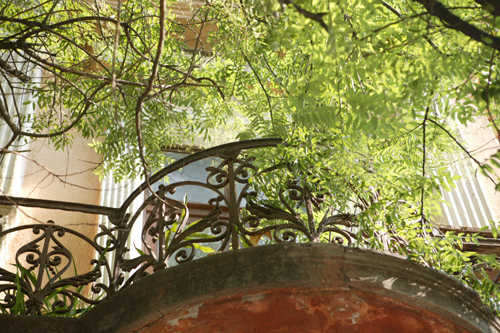
Some did not survive and were replaced by ugly shitboxes.
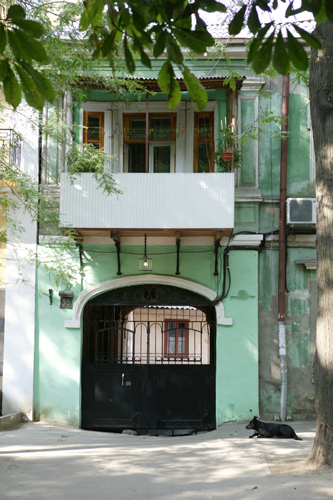
Some are unsafe Frankenstein monsters.
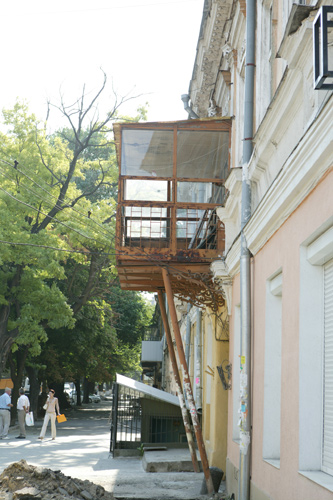
Some are huge, with fancy statues, and in horrible state of disrepair.
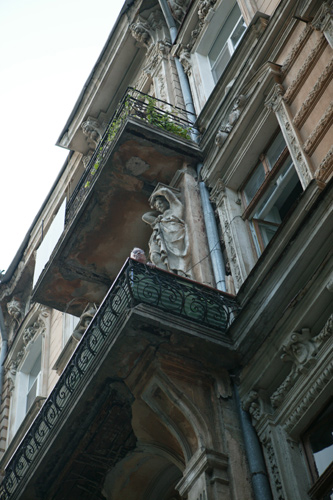
Some are maintained.
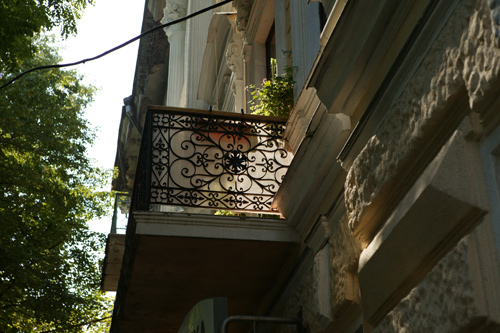
Some are elegant, curved around gorgeous bay windows. Notice the hanging laundry.
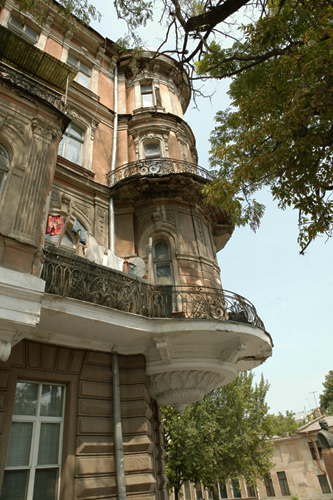
Some instead of laundry are draped in grapevines.
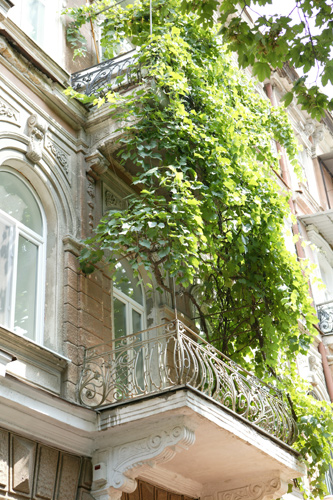
I have no idea how these grapevines survive: they grow in the street, are peed on by dogs and are never watered.
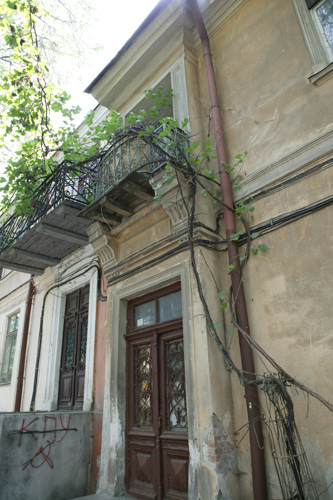
Some of the most gorgeous buildings with the most awesome balconies are in such state of disrepair, that in New York they would have been immediately boarded up, but yet there are people living there…
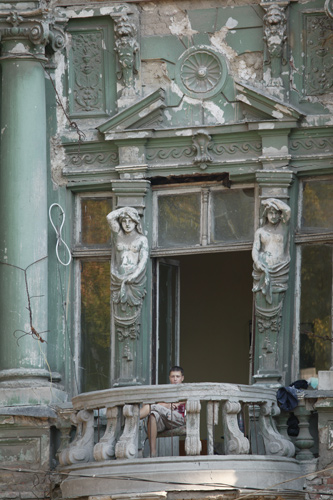
These old buildings are what New York realtors are referring to as “pre-war”: they have very tall ceilings, big rooms, parquet floors, fireplaces, and other bourgeoisie niceties. After the revolution most of these apartments where turned into communal flats: instead of a single family with help, now 5-7 families were crammed into it. The process kind of reversed itself in the 90s, with rich people buying out communal dwellers, but some still remain: here’s a picture of the doorbells on one door. You can visit a site about communal living in Russia. Interestingly enough, despite the Marxist spirit, in communal apartments even the doorbells were hooked up to separate electric meters, and the excessive use of a lightbulb in bathroom was a major point of contention.
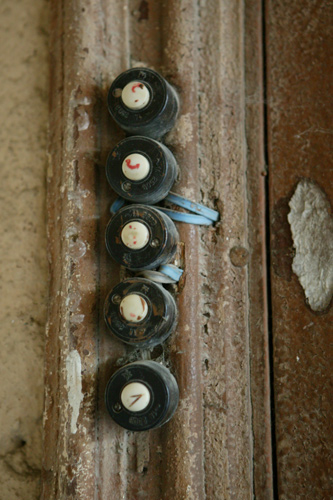
These buildings are old: many have horse hitches out front:
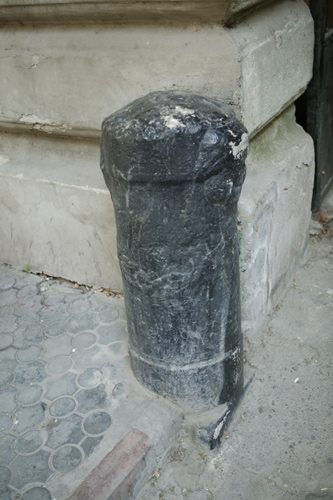
Once you tied your horse down, you enter the building through a gate.
Sometimes the gate is old and beautiful.
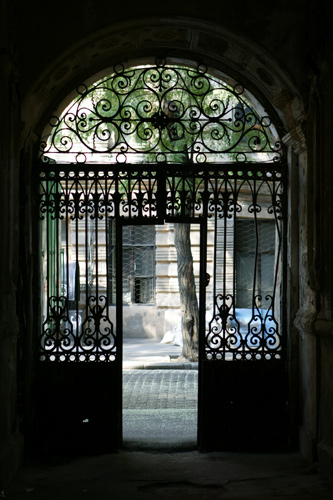
Sometimes it was replaced by a horrible modern monstrosity painted with signs like “angry dog” and “there’s no toilet here”.
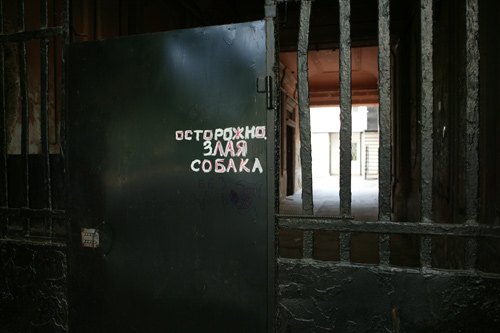
Sometimes it’s missing altogether.
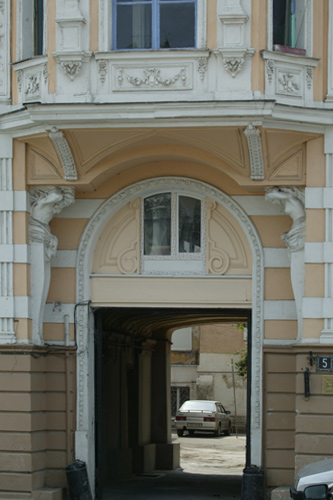
The gate leads you through a passageway. What will you find in that passageway?
A bunch of semi-destroyed soviet-era mailboxes. I am not sure if they are still in use. Here’s one of the better preserved specimen.
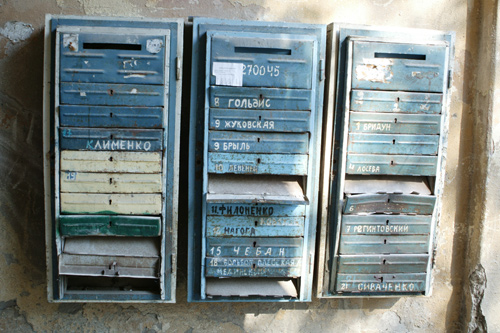
The passageway, a utility space, often has interesting ceilings, which are almost always mostly ruined.
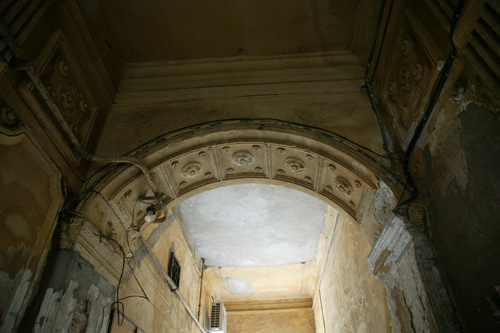
Some are less ornate though.
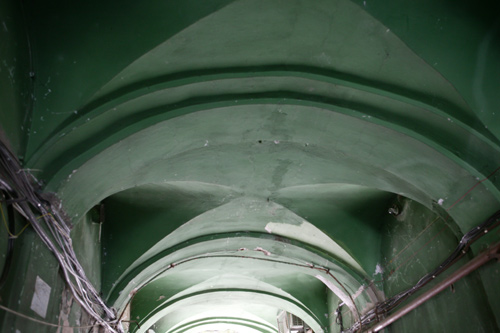
Often there are very cool windows within the passageways.
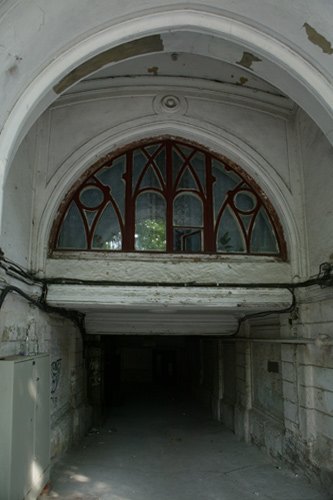
The passageway will lead you into the yard. There will be entrances to apartments, parked cars, laundry.
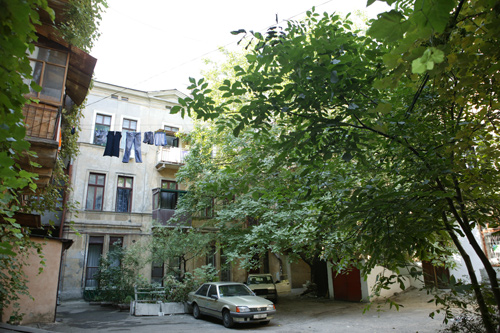
Here’s something that used to be very common, but is actually a rarity now: drying plastic bags.
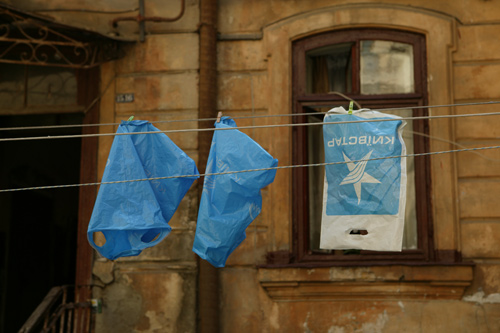
Some more cars and a kid riding a bike.
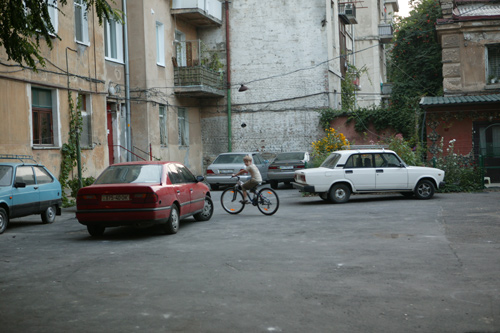
Grapevines, cats, old cars.
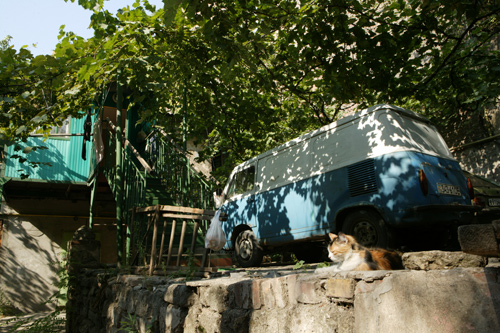
Restored all cars and walls that are in bad need of restoration.
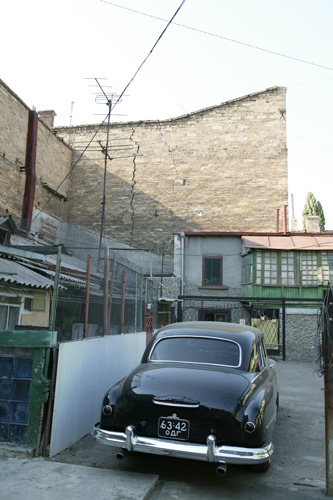
Sleeping dogs and more drying laundry.
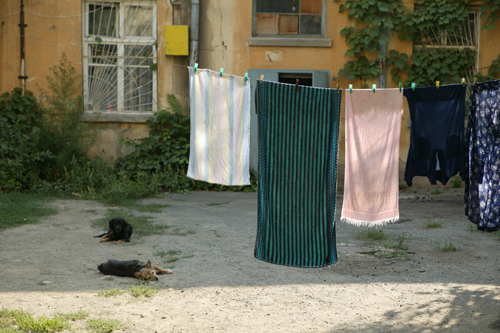
A non-functioning fountain.
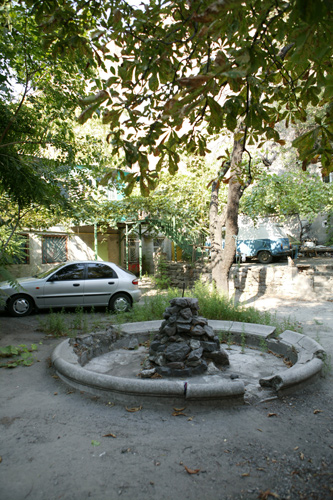
A little garden. This one used to be my grandmother’s.
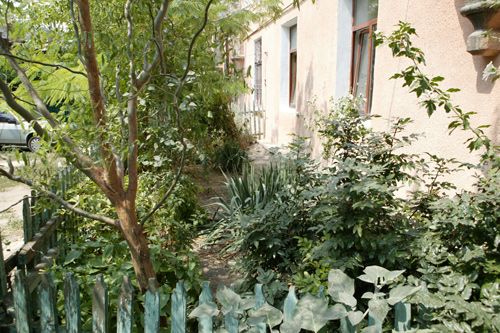
A granny reading a newspaper.
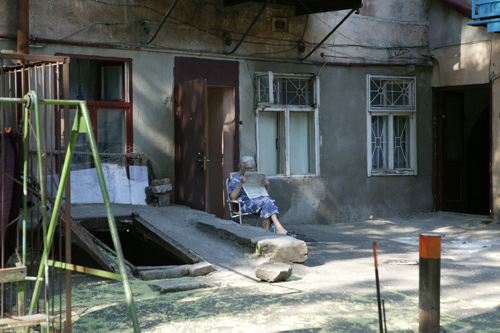
Peeling walls: I distinctly remember this particular wall from my childhood, it used to look exactly the same. It’s a testament to the quality of work of the old builders that with next to zero maintenance these buildings survive.
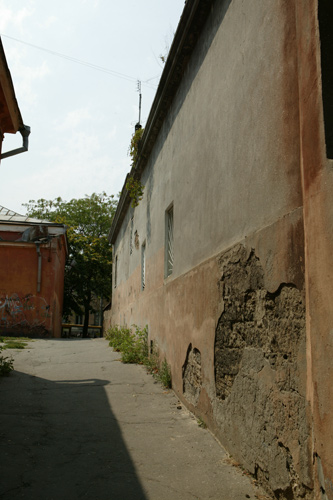
A seemingly functional pigeon coop.
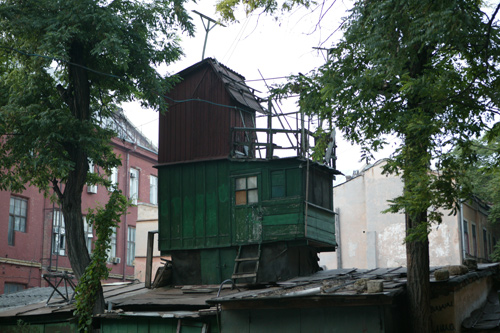
An old tree. These old trees move move in the wind in a very hypnotic manner. Being so tall, they can be used to forecast the size of waves in the sea by the speed at which the tops of them move.
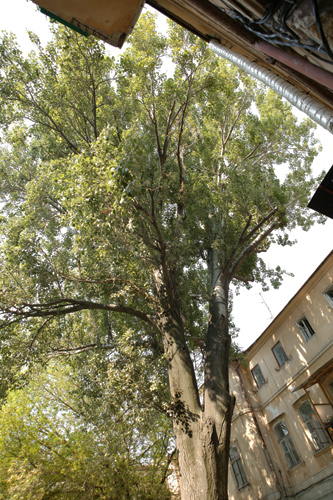
A decorative drinking well. I’m not sure, but it kind of looks like it could have been a real well once.
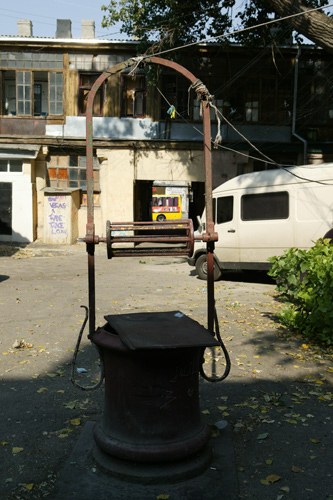
A woman feeding cats who will tell you to stop taking stupid pictures like the dumbass that you are and go and do something productive.
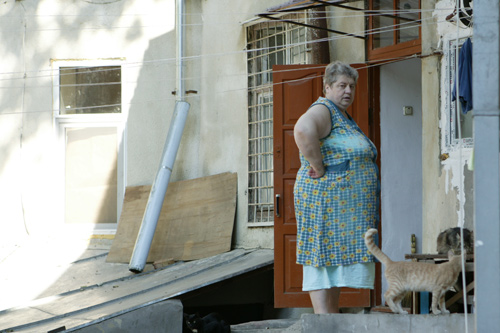
Walls with WWII bullet holes. Odessa is one of the few cities granted the designation of hero city for valiant resistance. When the Germans and Romanians entered the city there was a lot of executions.
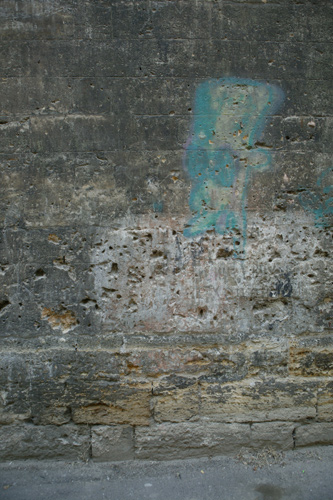
A sad, sad sight: an ad for apartments in a newly constructed building.
